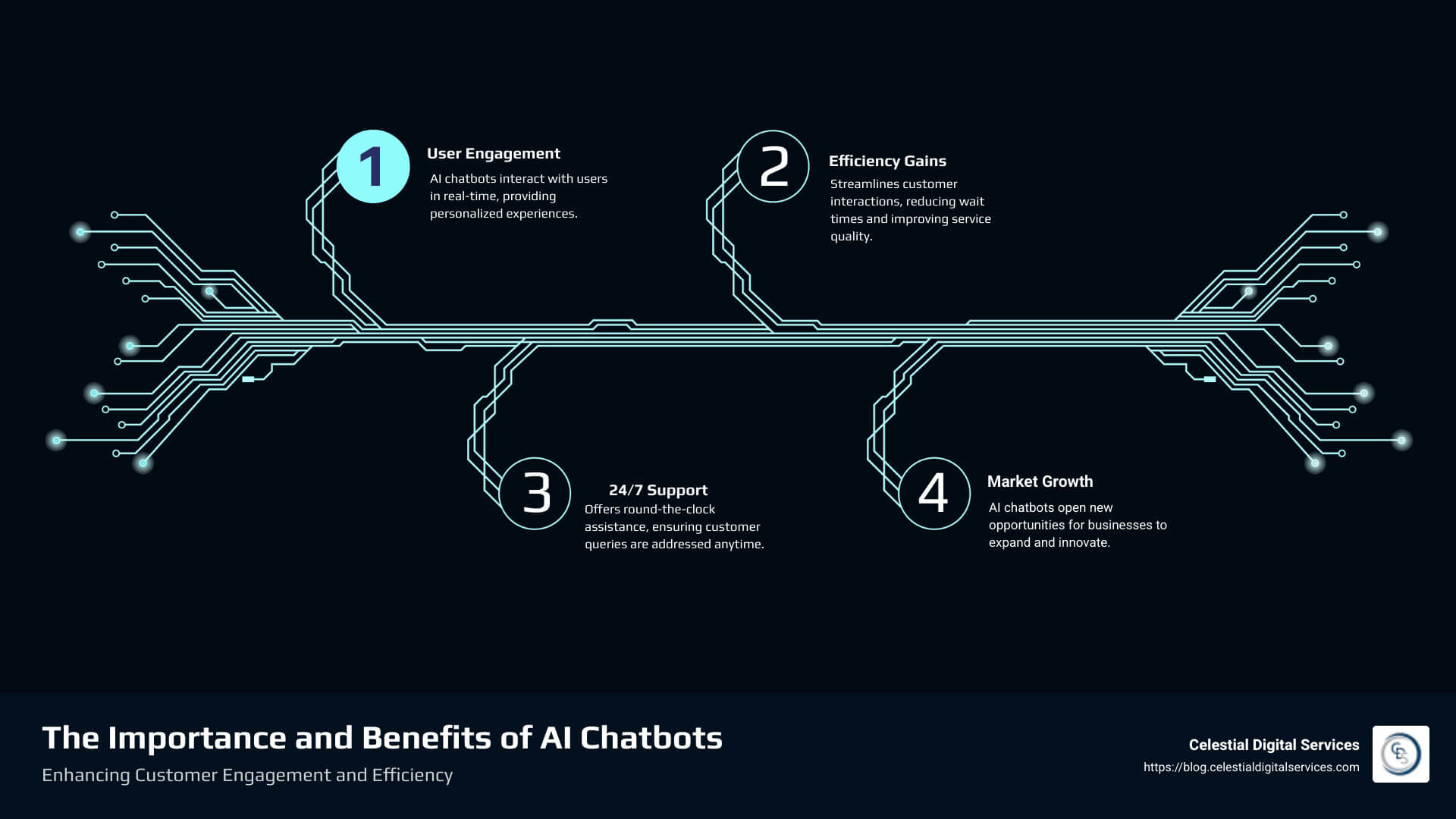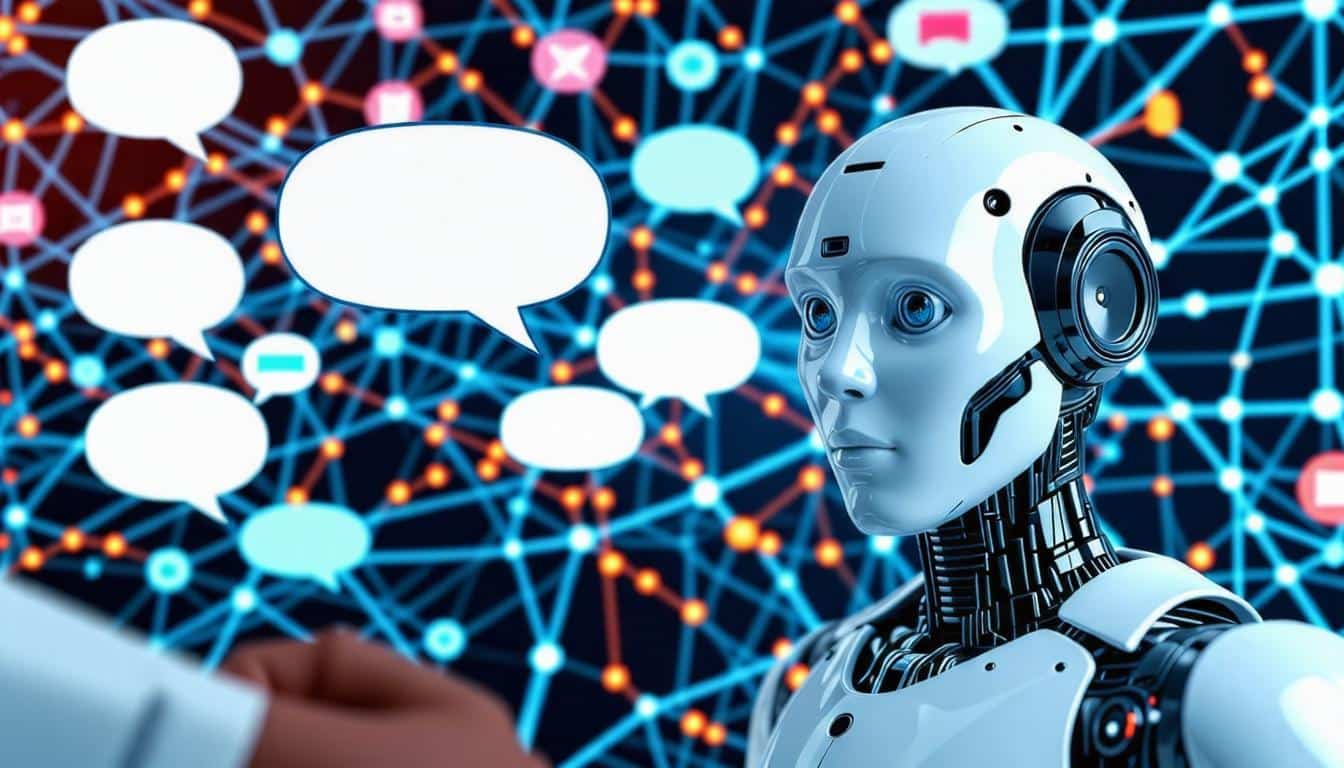AI chatbot development is rapidly changing how businesses engage with customers. Chatbots have become vital tools for enhancing user experiences, streamlining interactions, and advancing productivity. They use complex algorithms to understand and respond to customer queries, making customer service more efficient and effective.
Here’s a quick breakdown if you’re exploring AI chatbot development:
-
What Are AI Chatbots?
Software that uses artificial intelligence to mimic human-like conversations. -
Why Use Them?
They boost user engagement, improve efficiency, and enable 24/7 customer support. -
Market Potential:
Witnessing rapid growth, with massive opportunities for businesses across industries.
AI chatbots are changing the way businesses talk to their customers. These smart tools help improve interactions and make them more engaging. In this guide, we’ll explore how developing AI chatbots can transform customer service, making it more efficient and personal. Get ready to find a new world of digital communication!

Understanding AI Chatbot Development
AI chatbot development is a fascinating journey into machine learning, natural language processing (NLP), and natural language understanding (NLU). These technologies work together to create chatbots that can understand, interpret, and respond to human language in a way that feels natural and intuitive.
The Role of Machine Learning
Machine learning is at the heart of AI chatbot development. It allows chatbots to learn from data and improve over time. By analyzing past interactions, machine learning algorithms can predict user needs and provide more accurate responses.
-
Supervised Learning: This involves training the chatbot with labeled data. It helps the bot learn the correct responses to specific queries.
-
Reinforcement Learning: Here, the chatbot learns by trial and error, receiving rewards for correct answers and penalties for incorrect ones. This process helps refine the chatbot’s ability to handle complex interactions.
Natural Language Processing (NLP) and Understanding (NLU)
NLP and NLU are crucial for enabling chatbots to understand and generate human language. They break down language into understandable parts and help the chatbot grasp the meaning behind words.
-
Tokenization and Parsing: These processes split text into smaller units and analyze its grammatical structure, allowing the chatbot to understand context and intent.
-
Named Entity Recognition (NER): This identifies key elements like names, dates, and locations, helping the chatbot provide relevant responses.
The Evolution of Chatbots
Chatbots have come a long way since their inception. Early chatbots like ELIZA were rule-based and limited in scope. Today, advanced models like GPT (Generative Pre-trained Transformer) leverage deep learning to offer more complex and human-like interactions.
The evolution of chatbots is marked by several key milestones:
-
Recurrent Neural Networks (RNNs): These were pivotal in handling sequential data, maintaining context over multiple interactions.
-
Transformers: Models like GPT have revolutionized chatbot capabilities, enabling them to process entire sequences of words at once and handle longer dependencies effectively.

Real-World Impact
AI chatbots are changing industries by enhancing customer experience and streamlining operations. For instance, businesses are using chatbots for customer support, reducing wait times, and providing instant answers.
According to a recent study, 80% of customers reported positive experiences when interacting with chatbots. This highlights the growing acceptance and reliance on AI chatbots for effective communication.
As we continue to advance in AI chatbot development, the potential for these digital assistants to transform customer interactions is immense. They are not just tools but partners in enhancing user engagement and operational efficiency.
In the next section, we’ll dive into the steps to build your own AI chatbot, exploring everything from defining your use case to launching and monitoring your bot.
Steps to Build Your Own AI Chatbot
Building an AI chatbot is an exciting journey that involves several key steps. Let’s break down the process into manageable parts to help you create a chatbot that meets your needs and exceeds user expectations.
1. Define Your Use Case
Before you start building, identify the purpose of your chatbot. Ask yourself:
- What problems will the chatbot solve?
- Who are the target users?
- In which industry will it operate?
For example, if you’re in retail, your chatbot might handle customer inquiries or assist with product recommendations.
2. Select the Right Channel
Decide where your chatbot will interact with users. Will it be on a website, a mobile app, or a messaging platform like WhatsApp or Facebook Messenger?
Choosing the right channel is crucial because it should align with where your target users are most active. Consider platforms like ManyChat for social media or UChat for broader audience reach.
3. Choose Your Tech Stack
Select the technologies that will power your chatbot. This includes:
- NLP Frameworks: Options like Dialogflow or Rasa can help your chatbot understand human language.
- Backend Development: Use languages like Node.js or Python to build robust backends.
- Frontend Tools: HTML/CSS, JavaScript, and React are popular for creating interactive user interfaces.
4. Build a Knowledge Base
Your chatbot needs a reservoir of information to pull from when answering questions. This knowledge base can be built by:
- Scanning your website or help center for FAQs.
- Integrating with databases or external APIs to fetch real-time data.
5. Design the Conversation Flow
Crafting a natural conversation flow is essential for a seamless user experience. Use tools like draw.io to map out interactions, ensuring the chatbot can handle various user inputs gracefully.
Focus on creating a logical flow with elements like greetings, questions, and error handling. This structure helps users steer the conversation easily.
6. Integrate and Test
Integrate your chatbot into the chosen platform and begin rigorous testing. Use a testing tool to simulate interactions and ensure everything works as intended.
Gather feedback from beta testers to refine responses and behavior. Testing helps catch issues early and improves the chatbot’s reliability.
7. Launch and Monitor
Once testing is complete, deploy your chatbot and start monitoring its performance. Use analytics tools to track usage and measure effectiveness.
Pay attention to user feedback and make adjustments as needed. Regular updates ensure your chatbot remains relevant and helpful.

By following these steps, you’ll be well on your way to creating a smart, efficient chatbot that improves user engagement and meets your business goals.
Next, we’ll explore emerging trends in AI chatbot development, including exciting advancements in transformer models and voice-enabled chatbots.
Emerging Trends in AI Chatbot Development
The world of AI chatbot development is rapidly evolving. Let’s explore some of the most exciting trends that are shaping the future of chatbots.
Transformer Models
Transformer models, like GPT-3, have revolutionized natural language processing. These models can generate human-like text and understand context over long conversations. They are the backbone of many advanced chatbots today.
Why are they important? Transformer models enable chatbots to handle complex queries and provide coherent responses. This makes interactions feel more natural and engaging.
Voice-Enabled Chatbots
Voice-enabled chatbots are becoming increasingly popular. With the rise of smart speakers and voice assistants, users expect to interact with technology using their voice.
What’s the big deal? Voice-enabled chatbots offer a hands-free experience. They can assist users while they drive, cook, or even exercise, making them a versatile tool in various settings.
Visual Recognition
Imagine a chatbot that can “see” the world around it. That’s the promise of chatbots with visual recognition capabilities. These bots can identify objects and provide relevant information based on visual input.
How does this help? In retail, a visual recognition chatbot can help customers find products by simply taking a picture. In healthcare, it might assist doctors by analyzing medical images.
Sentiment Analysis
Understanding user emotions is crucial for creating meaningful interactions. Sentiment analysis allows chatbots to detect the emotional tone behind user messages.
Why does it matter? By gauging sentiment, chatbots can adjust their responses to be more empathetic. For instance, a chatbot could offer support if it detects frustration, enhancing user satisfaction.
Federated Learning
Federated learning is a technique that trains AI models across multiple devices without sharing data. This approach improves privacy and security.
What’s the advantage? Federated learning allows chatbots to improve over time while keeping user data safe. It’s a win-win for both privacy-conscious users and companies seeking to improve their AI capabilities.

These trends are not just buzzwords; they represent significant advancements in how chatbots operate and interact with users. As these technologies continue to develop, we’ll see chatbots become more intelligent, responsive, and integral to our daily lives.
Next, let’s explore the opportunities and challenges in AI chatbot development, including how these trends can lead to cost savings and improved customer experiences.
Opportunities and Challenges in AI Chatbot Development
AI chatbots are opening up a world of possibilities for businesses. But with great opportunities come significant challenges. Let’s explore both sides.
Opportunities
Cost Savings
AI chatbots can handle a large volume of customer inquiries at once. This reduces the need for human agents and cuts costs. A large telecom company saved millions annually by using an AI chatbot for customer service. Plus, chatbots work 24/7, ensuring continuous support without extra cost.
Improved Customer Experience
Chatbots offer personalized and context-aware responses. They remember past interactions and anticipate user needs, leading to more satisfying experiences. This boosts customer loyalty. Imagine a chatbot that knows your coffee order and suggests it every morning. That’s the power of personalization.
Data-Driven Insights
Every chatbot interaction generates valuable data. Analyzing this data reveals customer behavior and preferences. Businesses can use these insights to improve products and tailor marketing strategies. This data-driven approach leads to better decision-making.
Challenges
Data Privacy
Handling sensitive customer information requires strict data privacy measures. Chatbots must comply with regulations like GDPR. Ensuring data security is crucial to maintain user trust. One data breach can severely damage a company’s reputation.
Ethical AI
Bias in AI can lead to unfair outcomes. For example, a biased chatbot might inadvertently discriminate against certain groups. To avoid this, companies need diverse training data and regular bias checks. Ethical guidelines are essential to ensure fair AI practices.
Integration Complexities
Integrating chatbots with existing systems can be challenging. Legacy systems may not support new technologies. Ensuring seamless integration is vital for a smooth user experience. Regular testing and updates help mitigate technical issues.
These opportunities and challenges are shaping the landscape of AI chatbot development. By addressing these challenges, businesses can leverage chatbots effectively, enhancing customer engagement and operational efficiency.
Now, let’s move on to some frequently asked questions about AI chatbot development.
Frequently Asked Questions about AI Chatbot Development
What is AI chatbot development?
AI chatbot development involves creating software that can simulate human conversations. It uses AI technologies like machine learning (ML), natural language processing (NLP), and natural language understanding (NLU) to understand and respond to user queries.
NLP helps chatbots understand human language, while NLU allows them to grasp the meaning behind the words. This combination makes chatbots capable of engaging in dynamic interactions, not just following pre-set scripts.
How much does it cost to develop an AI chatbot?
The cost of developing an AI chatbot can vary widely. It depends on factors like complexity, features, and whether you’re opting for custom development or a Chatbot-as-a-Service (CaaS) solution.
-
Basic chatbots: These can cost between $1,000 and $5,000. They’re rule-based and handle simple tasks like FAQs.
-
Advanced chatbots: With features like NLP and integrations, costs range from $5,000 to $15,000. They use more sophisticated ML algorithms and can manage complex interactions.
-
Highly advanced chatbots: These can exceed $50,000. They involve advanced ML techniques, offering personalized experiences and multi-platform support.
Regular maintenance and updates are additional costs, typically ranging from $500 to $2,000 per month. For a rough estimate, businesses can use an app cost calculator to gauge potential expenses.
How are AI chatbots built?
Building an AI chatbot involves several steps and technologies:
-
Machine Learning Algorithms: These allow chatbots to learn from interactions and improve over time. Traditional ML requires training on large datasets, while advanced ML, like transformer models, can handle more complex language patterns.
-
Rule-Based Systems: These are simpler, relying on predefined scripts. They work well for straightforward tasks but lack flexibility.
-
Integration of NLP and NLU: NLP processes the language, and NLU interprets it. Together, they enable chatbots to deliver more human-like interactions.
-
Custom Development vs. CaaS: Custom development offers custom solutions but at a higher cost. CaaS provides ready-to-use platforms that are cost-effective and quick to deploy but might offer less customization.
The choice between different technologies and development approaches depends on the specific needs and budget of the business. AI chatbot development is a dynamic field, constantly evolving with new technologies and methodologies.
Next, let’s explore some emerging trends in AI chatbot development.
Conclusion
In the rapidly evolving world of digital solutions, Celestial Digital Services stands out as a guide for startups and local businesses aiming to thrive online. Our mission is clear: empower businesses with cutting-edge technology that simplifies digital marketing and improves online presence.
AI chatbot development is a crucial part of this mission. By integrating AI technologies into our services, we help businesses streamline operations, improve customer engagement, and achieve cost savings. Our chatbots are designed to be smart, reliable, and custom to meet the unique needs of each client.
Why choose us?
-
Custom Solutions: We understand that every business is unique. That’s why we offer personalized strategies to meet your specific needs. Whether you’re looking to improve customer service or automate repetitive tasks, we have the right solution for you.
-
Expertise and Support: Our team of professionals brings a wealth of knowledge in AI and digital marketing. We work closely with you to ensure successful implementation and ongoing support.
-
Commitment to Excellence: We are passionate about delivering top-notch services that consistently exceed expectations. Our goal is to help you stay ahead in a competitive online landscape.
By leveraging our expertise in AI chatbot development, businesses can open up new opportunities for growth and innovation. We invite you to explore our AI Optimization Services and find how we can empower your business to reach new heights.
In conclusion, as AI continues to transform industries, Celestial Digital Services is committed to leading the way. We are here to help you steer this exciting journey, providing the tools and support you need to succeed in the digital age. Let’s innovate, inform, and inspire—together.



